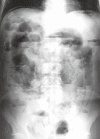Pneumatosis cystoides intestinalis after fluorouracil chemotherapy for rectal cancer
- PMID: 18506940
- PMCID: PMC2712867
- DOI: 10.3748/wjg.14.3273
Pneumatosis cystoides intestinalis after fluorouracil chemotherapy for rectal cancer
Abstract
Pneumatosis cystoides intestinalis (PCI) is a relatively rare condition characterized by intraluminal gas in the gastrointestinal tract. Several chemotherapeutic agents have been reported to be associated with PCI, although fluorouracil-related PCI is extremely rare. We report a case of a 76-year old man who received adjuvant chemotherapy for rectal cancer with fluorouracil (FU) and leucovorin (LV). After 1 cycle of the treatment, he presented with diarrhea and abdominal pain. Abdominal radiogram revealed the presence of free air under the diaphragm and intramural gas in the intestine. Laparotomy was performed, showing a suspected diagnosis of perforation in the gastrointestinal tract. Intraoperative findings revealed penumatosis of the intestine without evidence of perforation. He was treated supportively and his symptoms improved. In conclusion, we should consider the possibility of PCI occurring in patients with malignancies during chemotherapy treatment.
Figures



References
-
- Poon MA, O'Connell MJ, Wieand HS, Krook JE, Gerstner JB, Tschetter LK, Levitt R, Kardinal CG, Mailliard JA. Biochemical modulation of fluorouracil with leucovorin: confirmatory evidence of improved therapeutic efficacy in advanced colorectal cancer. J Clin Oncol. 1991;9:1967–1972. - PubMed
-
- Yoshino M, Ota K, Kurihara M, Akazawa S, Tominaga T, Sasaki T, Konishi T, Kodaira S, Kumai K, Sugano K. [Late phase II trial of high-dose l-leucovorin and 5-fluorouracil in advanced colorectal carcinoma. l-Leucovorin and 5-FU Study Group (Japan Eastern Group)] Gan To Kagaku Ryoho. 1995;22:785–792. - PubMed
-
- Fata F, Ron IG, Kemeny N, O'Reilly E, Klimstra D, Kelsen DP. 5-fluorouracil-induced small bowel toxicity in patients with colorectal carcinoma. Cancer. 1999;86:1129–1134. - PubMed
-
- Bucaloiu ID, Dubagunta S, Pachipala KK, Kamal N, Fata F. Small-cell cancers, and an unusual reaction to chemotherapy: Case 4. Fluorouracil-related small bowel vasculitis. J Clin Oncol. 2003;21:2442–2443. - PubMed
-
- Galm O, Fabry U, Adam G, Osieka R. Pneumatosis intestinalis following cytotoxic or immunosuppressive treatment. Digestion. 2001;64:128–132. - PubMed
Publication types
MeSH terms
Substances
LinkOut - more resources
Full Text Sources
Medical
Miscellaneous

